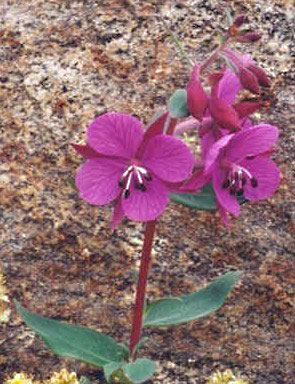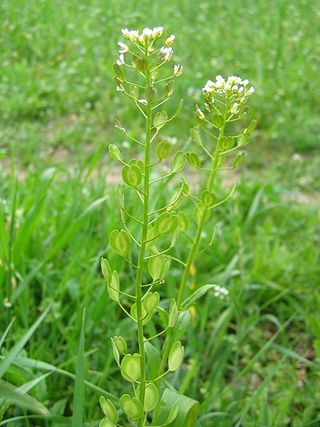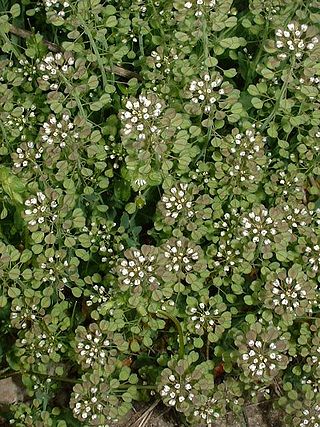Thlaspi alpestre may refer to two different plant species:
- Thlaspi alpestre(L.) L., a synonym for Noccaea caerulescens
- Thlaspi alpestreVill., a synonym for Noccaea caerulescens
- Thlaspi alpestreJacq., a synonym for Noccaea alpestris
Thlaspi alpestre may refer to two different plant species:

Bellis is a genus of flowering plants in the family Asteraceae.

The Onagraceae are a family of flowering plants known as the willowherb family or evening primrose family. They include about 650 species of herbs, shrubs, and trees in 17 genera. The family is widespread, occurring on every continent from boreal to tropical regions.
A hyperaccumulator is a plant capable of growing in soil or water with very high concentrations of metals, absorbing these metals through their roots, and concentrating extremely high levels of metals in their tissues. The metals are concentrated at levels that are toxic to closely related species not adapted to growing on the metalliferous soils. Compared to non-hyperaccumulating species, hyperaccumulator roots extract the metal from the soil at a higher rate, transfer it more quickly to their shoots, and store large amounts in leaves and roots. The ability to hyperaccumulate toxic metals compared to related species has been shown to be due to differential gene expression and regulation of the same genes in both plants.
Alpine pennycress is a common name for several plants and may refer to:
Leadwort is a common name for various flowering plants in the family Plumbaginaceae, in particular those in the genera:

Thlaspi, or pennycress, is a genus of herbs of temperate regions of the Eurasian continent. They occur in Central and South Europe, South-West Asia and two species are endemic to China. The Thlaspi has been proven to be a hyperaccumulator of heavy metals such as zinc and cadmium and therefore may be used in phytoremediation initiatives.

Thlaspi arvense, known by the common name field pennycress, is a flowering plant in the cabbage family Brassicaceae. It is native to Eurasia, and is a common weed throughout much of North America and its home.
This list covers known nickel hyperaccumulators, accumulators or plant species tolerant to nickel.
The Botanical and Zoological Codes of nomenclature treat the concept of synonymy differently.

The blue mockingbird is a species of bird in the family Mimidae. It is endemic to Mexico, but has occurred as a vagrant in the southern United States. Its natural habitats are subtropical or tropical dry forests, subtropical or tropical moist montane forests, and heavily degraded former forest.
T. arvense may refer to:

Thlaspi californicum is a rare species of flowering plant in the family Brassicaceae known by the common name Kneeland Prairie penny-cress. It is endemic to California, where it is known from only one stretch of grassland in Humboldt County. It is threatened by development. It is a federally listed endangered species of the United States.

The Allen Confluence Gravels is the name given to a Site of Special Scientific Interest (SSSI) in Northumberland, England. The site, listed since 1968, has an 'outstanding assemblage of river margin invertebrates.'
Spirobranchus kraussii, the blue coral-worm, is a species of marine invertebrate in the family Serpulidae of order Sabellida. It is native to the Indian Ocean.

Prasophyllum alpestre, commonly known as the mauve leek orchid, is a species of orchid endemic to eastern Australia. It has a single tubular, green leaf and up to twenty five scented, white, purplish and green flowers. It grows in subalpine parts of New South Wales, Victoria and Tasmania.

Noccaea is a problematic genus of flowering plants in the family Brassicaceae, native to temperate areas of western North America, southern South America, northern Africa, Europe and Asia.

Trifolium alpestre, the owl-head clover or purple-globe clover, is a species of flowering plant in the family Fabaceae, native to central, southern and Eastern Europe, the Caucasus, Turkey, and Iran. It reproduces both clonally and by seed.

Thlaspi perfoliatum is a species of plants in the family Brassicaceae.